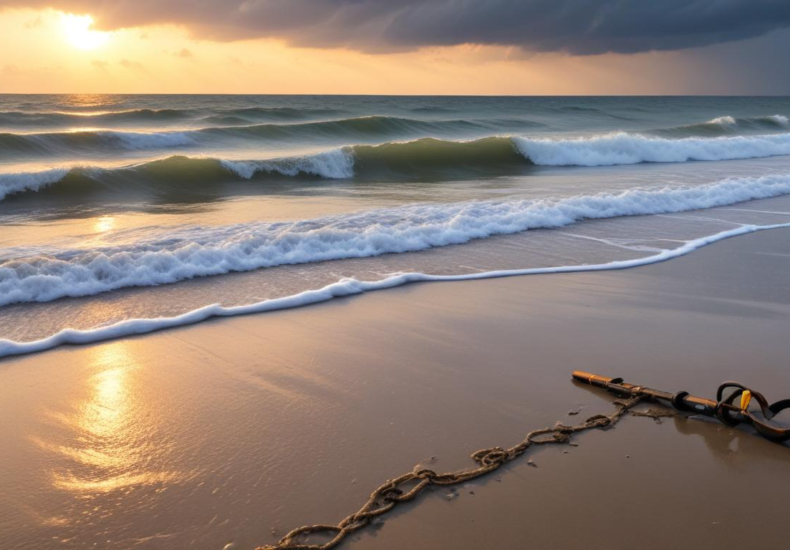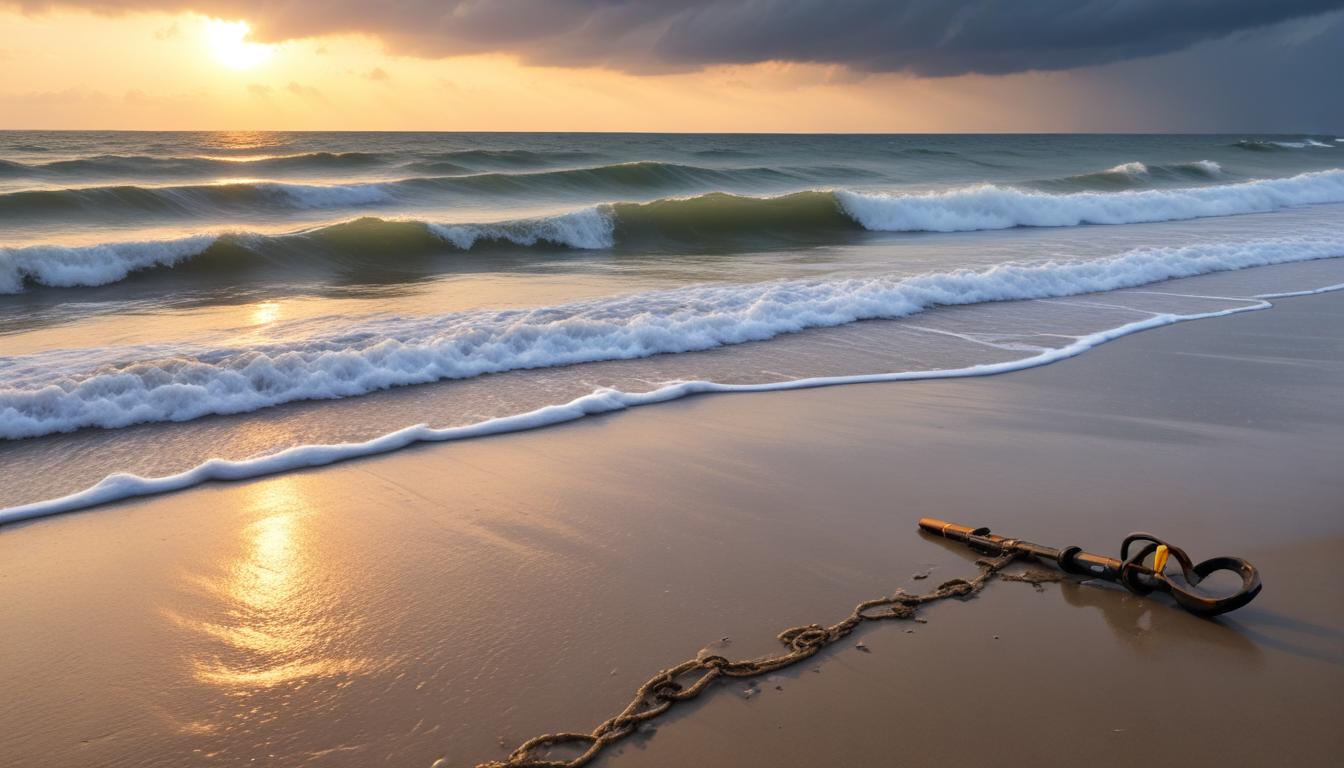
How storms impact beach metal detecting opportunities
Storms play a significant role in shaping the coastal landscape, often causing dramatic changes in beach sediment and erosion patterns. The power of storm surges and high winds can erode the beachfront, redistributing sand and other materials along the shore. This process can lead not only to altered beach profiles but also to new deposits of materials brought from deeper waters or neighboring areas.
Such storm erosion can significantly benefit beach detecting enthusiasts, as the shifting sands might uncover hidden treasures that have been buried for decades or even centuries. The action of a storm can sweep away layers of sand that previously made these objects inaccessible. Moreover, the eroded beach might expose older, more compact layers of sand, which are often richer in finds due to their historical accumulation.
However, the benefits of storm erosion need to be balanced with the changes it brings to the beach environment. The same storm surges that uncover deeper sediments can also wash away lighter, newer layers of beach sand, potentially carrying away recently lost items before they can be detected. Thus, while storms can create exciting opportunities for metal detecting, they also reshape the challenges that detectors face. Understanding these dynamic conditions is crucial for anyone engaged in beach detecting after a storm.
Changes in metal distribution during storms
Storms, with their potent combination of wind, rain, and waves, serve as natural forces that redistribute metallic objects along the coastline. As these severe weather events churn the ocean, they can pull items from their resting places out to sea or push them onto the shore from deeper waters. This phenomenon significantly alters the distribution of metal objects, potentially increasing the richness of finds available to beach detecting enthusiasts.
Detecting after such events, however, requires an understanding of how these forces operate. For instance, the swirling waters created by a storm can act like a giant sieve, sorting and depositing items based on weight and size. Heavier objects such as old coins, relics, or even shipwreck artifacts might be dropped closer to the shoreline, while lighter items can be scattered over a wider area or even pulled back into the sea.
This redistribution can create unusual opportunities for detectorists. Areas that were previously unproductive might suddenly yield finds, as objects previously stuck in underwater or deeper sediment layers are moved to more accessible zones. Conversely, familiar and typically productive spots might see a temporary decrease in finds until new deposits are made by subsequent tidal actions or storms.
Understanding the intricacies of how metals are redistributed by storms can enhance a detectorist’s strategy. For example, focusing efforts along the new high-tide mark or at the base of eroded sand cliffs can often be fruitful. Observing patterns in how debris is deposited along the beach can also guide enthusiasts to areas more likely to contain heavier and older items, brought to the surface by the storm’s powerful effects.
It’s important to note that these changes in metal distribution are not permanent. Continuous oceanic and human activity can further shift these newly laid deposits, highlighting the ever-changing nature of beach detecting environments following storm events. Successful enthusiasts will continuously adapt their strategies to these dynamic conditions, maximizing the opportunities presented by each new storm’s aftermath.
Best timing for metal detecting post-storm
The ideal timing for engaging in beach detecting after a storm is crucial for maximizing the chances of making significant finds. Typically, the best time to start searching is within a few days after the storm has subsided. This timing takes advantage of the storm’s immediate effects on the beach’s landscape, where recently unearthed or redistributed objects are more likely to be lying close to the surface before they are either buried again by shifting sands or picked up by other detectorists.
Immediately following a storm, the beach may still be reconfiguring itself, the tides influenced by the residual swells. This is when objects brought closer to shore or unearthed by the storm’s powerful waves are most accessible. Detectorists should pay close attention to the tides; low tide, particularly the first low tide after the storm, typically reveals the most new surface area exposed by the storm erosion, and thus benefits those searching for buried treasures.
However, one should approach this window of opportunity with flexibility. If the storm was particularly fierce or coincided with other natural phenomena like exceptionally high tides, the best times might shift slightly. Some experienced beach detectors suggest waiting for one or two tidal cycles to pass. This wait allows the sea to sort and settle the newly shifted sands and potentially reveal more items washed up during the storm.
During this optimal post-storm period, the areas most likely to yield discoveries are those where natural and storm-induced barriers trap heavier items. Places like depressions on the beach, around rock jetties, and at the bases of cliffs are spots where items accumulate. Beach detecting after a storm often requires a keen eye for understanding how new channels and barriers formed by storm erosion might influence where objects settle.
Ultimately, succeeding in beach detecting under these conditions demands a good balance of timely intervention and strategic patience. While the immediate aftermath provides an exciting opportunity to find objects brought to the surface by the storm, understanding the beach’s evolving landscape in the days following will serve as an advantage. Regular visits and keen observations post-storm significantly increase the likelihood of rewarding finds.
Safety considerations for beach detecting after storms

When considering beach detecting after storms, it’s imperative to prioritize safety, as the beach environment can be significantly more hazardous. Storms can leave behind dangerous debris such as sharp metal objects, broken glass, and jagged wood that are not only harmful to beachgoers but also pose a significant risk to detectorists who may not see these hazards buried under the sand.
Firstly, it’s crucial to check local advisories before heading to the beach. Authorities might close beaches for safety inspections, especially if the storm has been severe. Respecting these restrictions is important not only for your safety but also to comply with local regulations. Additionally, be mindful of the beach’s structural integrity. Storm erosion can benefit detectorists by exposing new layers of sand and potential finds, but it can also make the terrain unstable. Areas near cliffs or dunes might have become weakened and could collapse without warning.
Another safety consideration is the potential for encountering wildlife displaced by the storm. Snakes, marine animals, and insects might have been brought closer to the surface or to the shore. Wear protective gloves and boots to guard against bites and stings. It’s also advisable to carry a stick or a probe to check areas before digging.
While metal detecting, stay aware of your surroundings. Post-storm beaches can attract other treasure hunters and sightseers, potentially leading to crowded conditions. Keep a respectful distance, and be cautious of others when swinging your detector or digging. Additionally, the beach detecting gear itself might require special consideration after a storm. Waterproof and storm-resistant equipment will perform better under wet conditions and offer protection against sudden weather changes, which are common after storms.
Lastly, never underestimate the ocean’s power, especially after a storm. Tides can be unpredictable, and rip currents may be stronger. Always keep an eye on the tide and weather reports to avoid being caught in a dangerous situation. Let someone know your plans and expected return time, ensuring that help is available if needed.
By taking these precautions, beach detecting after a storm can not only be productive but also a safe and enjoyable activity. Remember, the ultimate treasure on any treasure-hunting excursion is returning home safely.
Case studies: Successful finds following major storms
One notable case involved a detectorist in Florida who ventured out after Hurricane Irma in 2017. The storm had battered the southeastern coast, altering the contours of many beaches. This detectorist decided to search an area where storm erosion had exposed a section of an older, previously buried sandbar. There, the individual uncovered a cache of Spanish coins from the 1700s, believed to have been part of a shipwreck dispersed by centuries of storms and currents. The remarkable find underscored how storm erosion can benefit beach detecting, revealing historical treasures that are otherwise hidden beneath layers of sand.
Another instance occurred after Superstorm Sandy hit the northeastern United States in 2012. Known for its devastating impact, Sandy also churned up the seabed and coastal sands in a way that few other storms had. Detecting enthusiasts in New Jersey reported an unusual increase in finds in the weeks following the storm. Among these was a colonial-era belt buckle and several Native American artifacts, items that had perhaps been buried for centuries. The reconfiguration of sand and debris by the storm had played a crucial role in bringing these items within reach of a detector’s coil.
In the United Kingdom, after Storm Ciara and Dennis in early 2020, beaches along the North Sea witnessed similar phenomena. A group of amateur detectorists discovered a hoard of Viking coins on a beach in Yorkshire. The storms had significantly eroded the beach, cutting through sand dunes and exposing denser, historical layers. The coins, as historical experts later confirmed, likely formed part of a Viking hoard that could have been buried for safekeeping over a thousand years ago. Once again, the relentless forces of nature had managed to uncover another slice of hidden history, providing an unexpected storm erosion benefit to the beach detecting community.
These case studies exemplify how the immediate aftermath of major storms can create fleeting but potentially lucrative opportunities for those engaged in beach detecting. They illustrate not only the dramatic changes that storms can inflict on the coastal landscape but also the potential rewards for those intrepid enough to explore these newly altered terrains. While each storm carries unique challenges and impacts, the common thread is their capacity to unveil relics of the past, offering a silver lining to the often destructive nature of these natural events.
You may also like
Archives
Calendar
| M | T | W | T | F | S | S |
|---|---|---|---|---|---|---|
| 1 | 2 | |||||
| 3 | 4 | 5 | 6 | 7 | 8 | 9 |
| 10 | 11 | 12 | 13 | 14 | 15 | 16 |
| 17 | 18 | 19 | 20 | 21 | 22 | 23 |
| 24 | 25 | 26 | 27 | 28 | 29 | 30 |
Leave a Reply